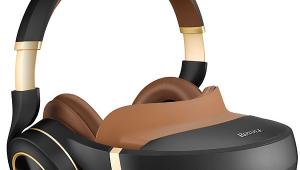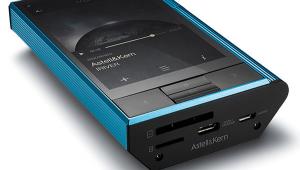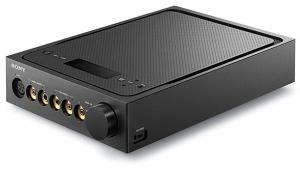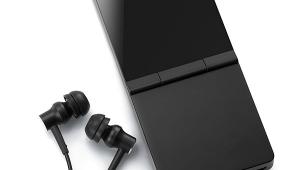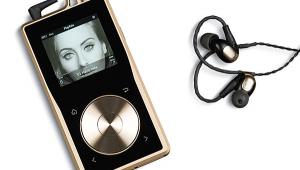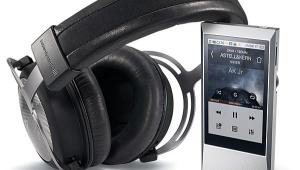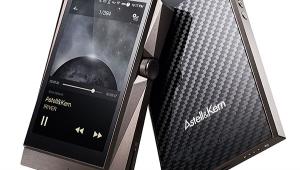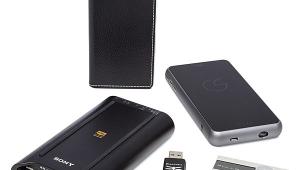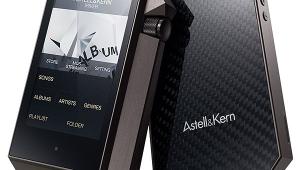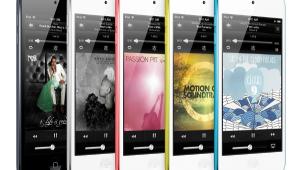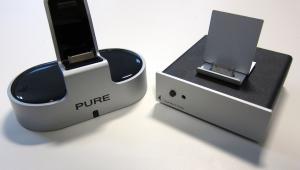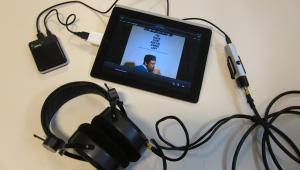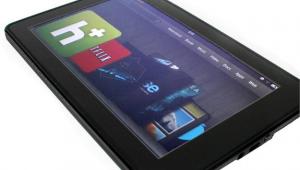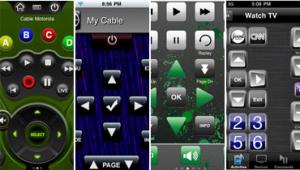Apple iPod Hi-Fi
I'm equally happy with my iPod nano and my IBM Windows PC. So, please don't mistake me for one of those sycophants who never has a bad word to say about Steve Jobs or a good one to say about Bill Gates. The little iPod nano has earned my admiration simply by being a good companion. When I'm not plugged into it, I hardly notice it. When I am, it's easy to get along with and rather entertaining.
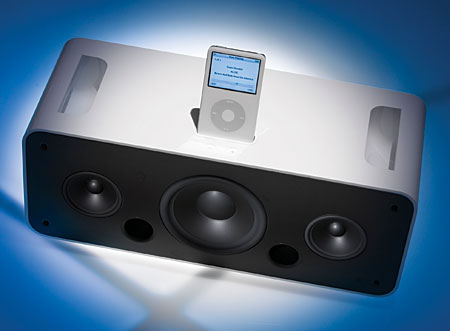
And now my companion has a companion, the Apple iPod Hi-Fi. The docking connector that comes on every recent iPod model joins the two together. The skinny 30-pin connector has already spawned a whole genre of iPod-compatible systems from the likes of Bose, which has been designing loudspeakers since 1964, and Klipsch, in business since 1946. That makes Apple the new kid on the audiophile block, but credit the company for taking a calm and deliberate approach to the R-and-D process before they released the Hi-Fi to an expectant world.
How expectant? The Apple people handed me a Hi-Fi following a press briefing at a fancy hotel—and I hadn't even gotten it into a cab before the hotel doorman asked me what I thought of it.
Not a Glorified Boom Box
The iPod Hi-Fi is about the size and shape of a boom box. It even has handles. In sensibility, though, it has more in common with the no-nonsense iPod. That alone should ship a lot of units. The device has a black front and white sides, so it will harmonize visually with either a white or black iPod.
You dock your iPod on the top of the enclosure. Apple supplies 10 snap-in cradles to fit most iPod models. (First- and second-generation iPods, plus the shuffle, lack the docking connector.) If your early iPod or other MP3 player hasn't got the docking connector, a minijack on the back will accommodate it.
The minijack accepts mini-Toslink digital signals, as well as analog ones, and that opens up some interesting possibilities. For example, you might use an AirPort Express to feed the Hi-Fi with streaming audio from your Mac or PC. Or the Hi-Fi might improve on your TV speakers if you place it atop your microdisplay and feed it the digital or analog output of a surround receiver. (Don't forget to tell the receiver you're using two speakers, not 5.1, and select stereo downmix on your DVD player.)
With drivers in the front, the top is the logical place for a volume control. And there it is, right in front of the dock, a pair of touch-sensitive plus/minus buttons. The back has only the minijack and power connector. This kind of simplicity is practically a declaration of independence.
There is a detachable power cord but no annoying wall wart, because the power supply is built into the unit. For portability, six D-cell batteries will also suffice. A fresh set of alkaline batteries will run the system for 5 to 15 hours, depending on how loud you play it. When it isn't running, the system remains in a low-power standby mode, so remove the batteries if you just use them on weekends. Like many other iPod-specific systems, this one charges the player through the dock. For tips on how to maximize an iPod's battery life, see www.apple.com/batteries/ipods.html.
Although it weighs 14.5 pounds without batteries, the Hi-Fi is not made of particleboard like most loudspeakers. The sealed enclosure is double-hulled plastic with a honeycombed interior to defeat resonance. A large, flat, thin rubber pad on the bottom prevents the Hi-Fi from interacting with hard surfaces. The grille will never buzz, because the baffle holes are spring-loaded, pulling the pins back into rubber-grommet cushions.
There are no tweeters here. The three treated-paper drivers in front consist of a pair of 3-inch full-range drivers flanking a single 5-inch woofer with a 180-hertz digital crossover. Each driver sits in a separate subenclosure, so the two front-panel ports affect only the woofer. Under the hood are Class D amps. Apple declines to provide a power spec: "This metric is often abused," my contact said. But the unit is rated to play up to 108 decibels from 1 meter away on AC power and 102 dB on DC. That's more than loud enough for any sane person, especially if you aren't too far away.
The remote control is about the size of an iPod shuffle. With one button and a four-way rocker, it adjusts volume, skips tracks, plays, and pauses. A second button is labeled "Menu" but does not mimic the iPod's Menu function. Instead, its main purpose seems to be switching between the dock and minijack inputs. You can mute or unmute aux-in sources, as well.
Across a Crowded Room
The iPod Hi-Fi makes an excellent first impression and is suitable for long-term listening. What happens in between is a growing awareness of both its strengths, which are seductive, and its weaknesses, which derive mainly from its modest scale. I wouldn't dump my 5.1-channel reference system for it. But, once the Hi-Fi got into my home, it infused itself into the casual parts of my listening life—like the chamber music that plays when I read magazines, the classic rock that pumps me up when I'm tidying up, and maybe an occasional podcast while I wash the dishes.
Even more than component systems, compact systems are prone to sizzle-and-boom sonics. These qualities are immediately recognizable and more marketable to non-audiophiles. Apple, however, focused on the real fundamentals and got the midrange right. It's a natural, smooth, creamy, heartfelt midrange with no trace of aggressiveness or hype. And, thanks in part to the full-range drivers, it's fairly seamless. Voices are natural and stay that way as you move around the room.
The iPod Hi-Fi's high-frequency response is not as consistent. Fix on a tambourine, move around the room, and you can easily hear it diminish as you move off axis. The closer you sit, the more noticeable this effect becomes. If you're just 1 to 3 feet away, as you might be for desktop listening, cymbals get noticeably soft-focused if you move your ears up just 1 foot. I have a feeling that Apple designed the Hi-Fi more as an across-the-room system. Aim it right at your favorite seat, but place it as far away as possible to minimize the angle and maximize the sweet spot. Thanks to the remote, you won't have to cross the room to adjust the volume.
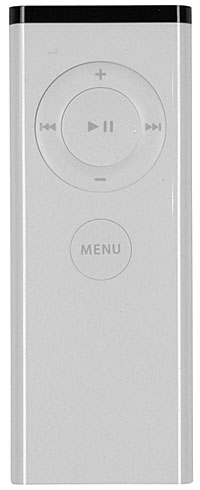 Bass from the single woofer is present but not unduly emphasized. The designers might have listened to some of the higher-end table radios, whose overaggressive bass becomes irritating for long-term listening. You can't use some of them within 3 feet of a wall, because the bass, especially with male voices, gets overwhelming. The Hi-Fi can go right up against a wall without booming. Attention to the enclosure has eliminated obvious distractions (rattles and buzzing), as well as more subtle ones (that hollow "plastic" sound). Knuckle-rap it, and what you'll hear is a solid thunk, just like a well-made high-end loudspeaker.
Bass from the single woofer is present but not unduly emphasized. The designers might have listened to some of the higher-end table radios, whose overaggressive bass becomes irritating for long-term listening. You can't use some of them within 3 feet of a wall, because the bass, especially with male voices, gets overwhelming. The Hi-Fi can go right up against a wall without booming. Attention to the enclosure has eliminated obvious distractions (rattles and buzzing), as well as more subtle ones (that hollow "plastic" sound). Knuckle-rap it, and what you'll hear is a solid thunk, just like a well-made high-end loudspeaker.
A Few Adjustments and Suggestions
If you want more sizzle or more boom and own an iPod nano or a fifth-generation iPod, you're in luck. Just for you, the Hi-Fi offers a Speakers menu that includes treble and bass boosts. If your Hi-Fi is away from the wall, you can use the bass boost to give bass guitar just the right lift without bending male voices out of shape. You might also use the treble boost to compensate for the off-axis high-frequency rolloff if you're listening at an angle. But you can't engage the bass and treble boosts simultaneously. If your iPod is neither nano nor fifth generation, you won't have a Speakers menu, but you'll still have the player's versatile EQ menu.
The Speakers menu also includes a four-position backlight control. You can have the backlight on or off all the time. You can also set it to run only when the iPod is playing or only momentarily when you press a key.
There is one operational subtlety that made me uncomfortable. While the remote adjusts volume and skips tracks, it does not navigate menus. That left me with two options when switching from one artist or album to another. I could remove the iPod from the dock, press buttons, and replace it, imposing some wear on the contacts. Or, with the unit docked, I could press buttons on the iPod using my thumb with a forefinger behind the unit to minimize bending of the female (iPod) and male (Hi-Fi) docking connectors. Either method required some delicacy and attention.
My suggestions: Adding functionality to the remote would reduce wear and tear on the docking connectors. Beefing up the dock with a backing structure (like that on the Klipsch iGroove) wouldn't hurt. Adding a sub output to the back panel would give rhythm sections more authority, while giving up little of the product's conceptual elegance.
By the time you read this, the Apple iPod Hi-Fi will already have become the most mercilessly scrutinized compact music system on the market. Within its self-imposed limits, it does a great job of delivering music as pleasingly and painlessly as possible. Every system has a personality—describing it is how I get the big bucks—and this one is amiable, pragmatic, sleek, minimalist, and musical.
Some people feel that component systems give you things you can't get any other way (including surround sound and monster bass). My rack is as busy as my refrigerator, and I wouldn't trade those voyages of discovery for anything. But moving the iPod Hi-Fi around my apartment gave me new insight into how even more music might fit into my life. The more, the merrier.
Highlights
• Rigorous, soothing simplicity of appearance and operation
• Stratospheric cool factor
• Meaty sound
